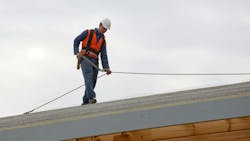Proactive Safety Planning is Vital to Construction Safety
Fall hazards are one of the most serious and persistent risks in the construction industry, especially in roofing and other construction work at elevation. Whether workers are installing shingles, repairing decking, or maintaining rooftop air conditioning units, the risk of falling is constant—and often has fatal results.
A Roofer Falls to His Death in Ohio
In October 2024, a roofing contractor in Ohio was cited by the Occupational Safety and Health Administration (OSHA) following a fatal fall at a residential re-roofing project. According to OSHA, one worker fell approximately 15 feet from the roof onto an asphalt driveway and died from acute blunt force trauma to his head and torso.
The agency launched an investigation and ultimately cited the employer for six alleged safety violations, proposing a combined penalty of $236,447. It's a steep penalty, but hardly the cost of human life. One of the violations was classified as willful, the most serious category under OSHA’s enforcement framework.
The centerpiece of OSHA’s citation was the allegation that the company failed to provide fall protection for employees working more than 6 feet above lower levels, as required by federal regulation. This willful citation alone accounted for $165,515 of the total proposed fine.
Here is a breakdown of the other citations:
- OSHA cited the company for allegedly failing to provide proper anchorage for personal fall arrest systems. According to the agency, “anchor points were installed by nailing ropes directly into the roof decking” instead of using reinforced anchors.
- OSHA also cited safety training violations, claiming multiple employees were not trained on fall hazards, procedures for inspecting fall protection systems or use of personal fall arrest systems.
- OSHA claimed the company failed to report a work-related fatality within eight hours, as required by regulation.
If OSHA’s allegations are accurate, this case—and many others like it—underscores the importance of having a thorough, well-executed safety program for fall protection. Proactive safety planning helps prevent injuries and limits the legal consequences that often follow serious workplace accidents.
Failing to Plan is Planning to Fail
For contractors, implementing a comprehensive safety program is essential to preventing injuries and complying with OSHA’s standards. Roofing work, for example, regularly exposes crews to serious hazards, including falls, ladder accidents, tool-related injuries, extreme heat and adverse weather. To that end, a strong safety program starts with a written safety manual—a foundational document that outlines company-wide safety policies and procedures.
This manual should cover essential topics, such as fall protection, personal protective equipment (PPE), ladder safety, emergency response, and who within the company is responsible for managing and enforcing safety. To secure employees’ compliance, the manual should be distributed to all employees, referenced often and updated regularly based on lessons learned in the field.
Building on the safety manual, contractors should develop a job hazard analysis (JHA) for each construction project. A JHA helps identify specific risks tied to individual tasks and work environments. For example, replacing a roof on a steep slope in high summer temperatures may require additional controls beyond what’s covered in the general manual, such as increased hydration breaks and modified work hours.
The JHA examines how each task interacts with the jobsite, the tools and the crew, giving employers a clear way to anticipate safety hazards before they occur. Together, the safety manual and JHA form a two-pronged approach: one sets the baseline and the other adapts company policy to the unique risks of each jobsite.
However, the most critical step of any safety program is implementation. Safety plans must move beyond paper and into daily practice. That means training workers before they ever step onto a jobsite, reinforcing safety expectations through supervision, and taking action when policies are ignored. Supervisors or designated safety personnel should inspect sites frequently and document any corrections made. Violations should be addressed with progressive discipline, starting with retraining and escalating to suspension or termination of employment when necessary.
Each of these actions should be documented in a centralized database in the event of future incidents. A well-implemented safety program not only reduces the risk of serious injury but also helps protect the business from costly enforcement actions, mitigating the risk of willful citation items.
Train Early and Often
A strong safety program begins with early and thorough training and keeps reinforcing it over time. New hires should receive hands-on instruction from a competent trainer before stepping onto their first jobsite. Companies with effective safety programs use this initial period to set expectations, establish safe work habits and explain the common risks (e.g., falls, ladder use and heat exposure).
Training should always be provided in a language which the worker is fluent in (typically, English or Spanish) to ensure comprehension. Additionally, before starting work and before starting any new or unfamiliar tasks, employees should be given a written test to confirm they understand core safety principles.
But wise employers don’t stop there. Construction safety programs also include consistent and ongoing training. For example, weekly toolbox talks are a practical tool for reinforcing key topics and identifying knowledge deficiencies. These short meetings double as informal check-ins where supervisors can ask questions and spot misunderstandings early. Many companies also hold periodic safety stand-downs or company-wide seminars to focus on high-risk areas. OSHA’s website is a useful resource, and its summaries of real-world safety incidents, such as the one referenced above, can be turned into case studies to drive home the importance of prevention.
Investing in outside training can strengthen both safety and regulatory compliance. Third-party providers offer specialized sessions on fall protection, and OSHA 10- and 30-hour courses are widely available. Many construction employers send frontline workers to OSHA 10 or fall-specific training, while supervisors complete the same courses, along with OSHA 30-hour certification. Employers can also bring in outside consultants to lead safety seminars or audit procedures. OSHA’s investigators tend to view these efforts favorably, especially where training can be independently verified.
It's Not a Matter of Luck
Roofing and other elevated construction work comes with serious risks, but those risks can be managed through planning, training and consistent enforcement. Companies with effective safety programs identify hazards, build clear written policies and implement job-specific plans that are actually followed in the field. They train workers early and often, supervise actively, and address violations before they lead to harm. This approach not only protects workers, but can also mitigate legal exposure should accidents occur. Like every other aspect of construction, a strong safety record reflects preparation and accountability, not luck.
About the Author

Travis S. McConnell
Travis S. McConnell is a construction attorney with Ready Legal, a business law firm located in Orlando, FL. His practice focuses on all aspects of construction law, including OSHA defense and compliance, lien and bond claims, construction defect litigation, and contractor licensing. He represents all members of the construction industry, including contractors, subcontractors, suppliers, property owners, and design professionals. He has been involved in construction and safety management for more than a decade, since serving in the U.S. Army as an Engineer Officer.
